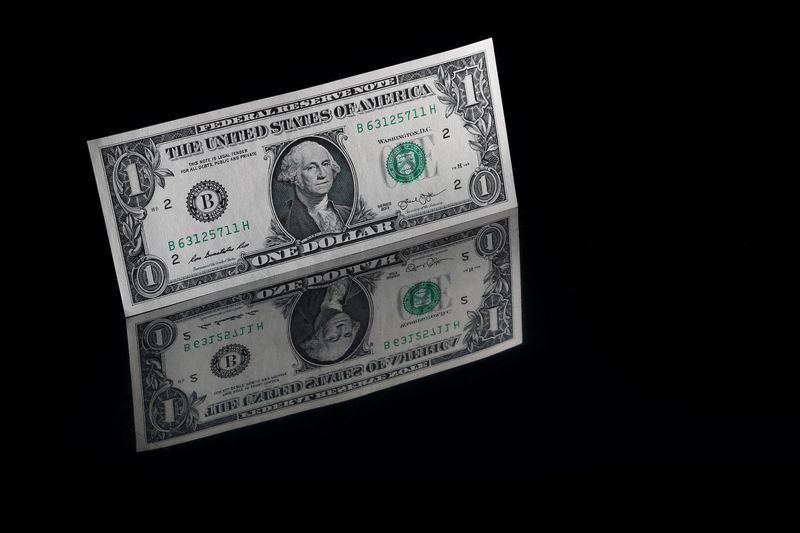By Saqib Iqbal Ahmed
NEW YORK (Reuters) - Currency market investors are less sure about the U.S. dollar's outlook now than they have been for many months, prompting sharp gyrations by the greenback last week despite red hot inflation data and a hawkish Federal Reserve.
"Everybody had been positioned for a stronger dollar" going into the new year, said Jack McIntyre, portfolio manager at Brandywine Global. Then last week, the U.S. Dollar Currency Index, which tracks the greenback against six major currencies, fell as much as 1.2% before paring loses to finish the week down 0.6%.
The drop came after Fed Chair Jerome Powell said the U.S. economy is ready for the start of tighter monetary policy and data that showed the largest annual rise in inflation in nearly four decades.
Dollar bears view the recent volatility as evidence that a lot of good U.S. economic news was already priced in after international Monetary Market speculators exited 2021 with a net long position in the dollar valued at about $20 billion, close to the most bullish in two years.
(GRAPHIC: USD positions, https://fingfx.thomsonreuters.com/gfx/mkt/akpezelqevr/USD%20positions.JPG)
For months, the dollar had been supported by the idea that monetary policy in the United States was likely to normalize at a faster pace than in many advanced economies. Now investors are growing more confident about other parts of the world, and looking for economies where growth could surprise to the upside.
Goldman Sachs (NYSE:GS) recently said the euro area will outgrow the U.S. economy over the next two years."I think we are seeing a transition in currency markets. It's less to do with relative monetary policy and more about relative growth," McIntyre said.
"It's not going to a straight line .. but at the end of 2022 the dollar will be weaker," McIntyre, who after having been generally neutral on the dollar for months has started selling dollars to fund the purchase of higher yielding currencies.
McIntyre said he is long the Australian dollar and the Swedish krona.
Investors were not rushing to buy dollars even as short-term U.S. Treasury yields climbed. A year-opening selloff in bond markets sent 2-year yields up by about 23 basis points this year. Lisa Shalett, chief investment officer at Morgan Stanley (NYSE:MS) Wealth Management, noted that flies in the face of the trend during 2021.
"This might signal a regime change in which the dollar peaks and begins reflecting a compression in relative growth and real yields versus the rest of world," Shalett said in a note.
The dollar could come under more pressure if global stocks start attracting money away from the United States, said Brian Rose, senior economist at UBS Global Wealth Management, noting the greenback was supported last year by strong capital flows into Wall Street.
International stock indexes that are off to a strong start this year include India's S&P BSE Sensex, up 4.3%, the UK's blue-chip FTSE 100 index, with a 2.4% gain and Hong Kong's Hang Seng Index, up 3.1%. The S&P 500 Index is down 4.0%.
"International investors hold a huge amount of dollar assets," Rose said. "We have thought for a long time that the dollar is vulnerable to capital flows suddenly reversing."
Paresh Upadhyaya, director of currency strategy at Amundi Pioneer, believes the dollar's safe haven-allure may falter if COVID-19 becomes less deadly and investors are less worried about severe economic ramifications.
"If we make that transition, all of a sudden the risks to growth diminishes," Upadhyaya said.
"The dollar loses that flight to quality sheen," he said.
HEALTH WARNING
Upadhyaya, however, has a health warning for those looking to jump on the dollar bear market band wagon, he said.
Markets may have not factored in the full extent of possible Fed hawkishness, including the potential some investors see for a 50-basis point interest rate hike as soon as March, Upadhyaya said.
"Given how fast the Fed were to react in terms of easing policy ...I also wouldn't rule out the possibility that the Fed may hike aggressively," he said.
A more aggressive Fed could also bolster dollar-focused carry trades, a strategy where investors sell low-yielding currencies to buy a higher yielding one and pocket the difference, analysts at HSBC said in a note last week.
Indeed, some investors used last week's dollar weakness as a buying opportunity.

"We have see some clients opportunistically buying dollars on this pullback," Peter Ng, senior FX trader at Silicon Valley Bank, said.
Despite the dollar's recent wobble, the spread between Treasury and German 10-year yields is at 185 basis points, about as favorable it was to the dollar as it was two months ago. "It has been a tough start to 2022 for the USD, but we view the fashionable disregard for relative monetary policy as unsustainable," analysts at HSBC said.